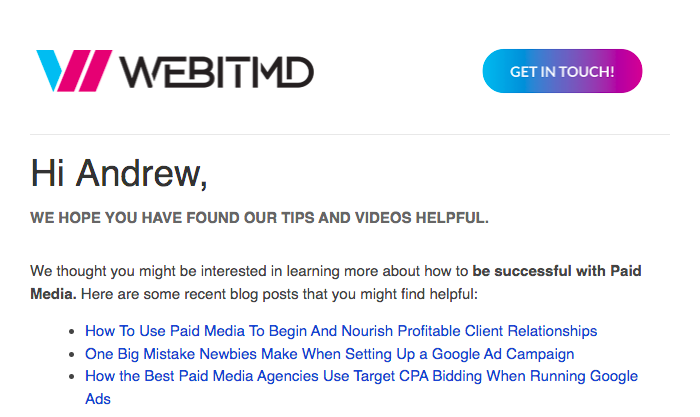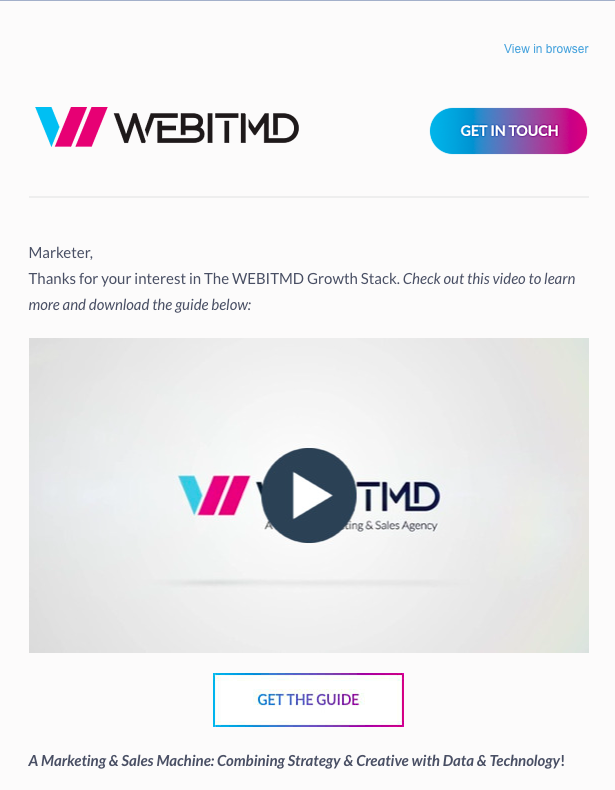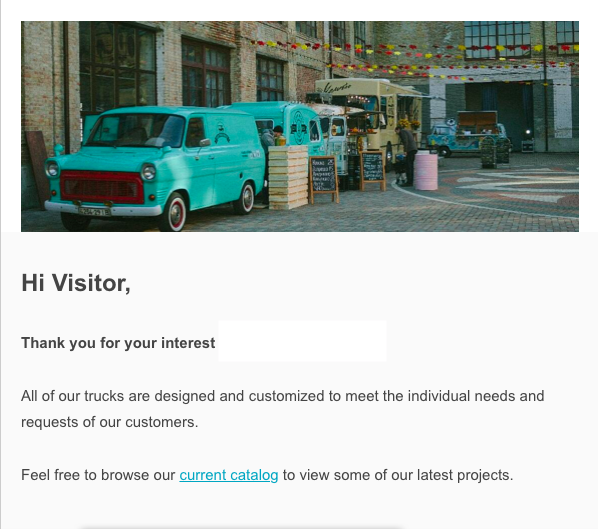Lead nurturing is an essential part of any marketing strategy. Without a proper email nurture sequence in place, you are letting a huge chunk of potential customers slip through the cracks.
If you are new to the concept of lead nurturing or marketing automation, this guide will help you create your first email nurture sequence that will convert new leads into actionable sales opportunities.
What is an email nurture sequence?
So you got a website conversion…that’s great! But this is just the beginning of the customer journey. That same contact is probably scoping out other companies and getting marketing materials from them, as well. The chances of them coming back to your website and making a purchase are slim.
Unless…
Creating an email nurture series is possibly the best way to bring visitors back to your website once you have their contact information. After somebody completes a form submission and voluntarily gives you their email address, you should continue that conversation with a series of automated emails. This is known as an email nurture sequence.
An email nurture sequence allows you to deliver helpful, relevant content to the right people at the right time. By doing so, you can keep your audience engaged and increase the chances of winning their business over your competitors. It sounds like a win/win, right?
How To Write a Good Nurture Email Sequence in 5 Steps
Building an effective email nurture sequence will take some time and planning. You don’t want to just throw some copy on a page and stick any old CTA at the bottom and call it a day.
Every email in your series should serve a distinct purpose and provide something of value to the recipient. Make sure you are thinking it through carefully and have a solid strategy in place, or you will see your unsubscribes racking up – and that is no bueno!
An effective email nurture sequence should demonstrate empathy and anticipate the types of questions your audience will have. Ask yourself:
- What problems are they facing at this moment?
- What are the best solutions to those problems?
- What resources and content can I provide that will be the most useful at this moment?
Once you can answer these questions for yourself, you are ready to get started with lead nurturing.
To help you get started building your first email nurture sequence, here is a framework you can follow:
Step 1: Establish enrollment and goal criteria
The purpose of an email nurture sequence is to take your leads from point A to point B. Map out your buyer’s journey first and identify what steps are involved in taking someone to the next stage in the process.
You first need to establish when and how to enroll contacts into your email nurture sequence. What should the trigger(s) be?
Keep it simple when building your first email nurture sequence and go after the low-hanging fruit. This will probably be a simple form submission or list membership. Common triggers you can consider might include:
- Submitted a form
- Lead status updated
- Downloaded a marketing asset
- Added to a contact list
After deciding what will trigger the emails, you want to determine the goal and when to stop the emails. In other words, What is the “point” of the sequence? What action do you want your contacts to take? Once they complete that action, it is time to remove them from the email nurture sequence.
There is no one-size-fits-all approach to building an email nurture sequence, so make sure you spend enough time planning out the beginning and end points because this will determine everything else you do moving forward.
Step 2: Create an outline for the sequence
Once you have determined the beginning and endpoints of your nurture sequence, you can create the outline. Remember that the goal of an email nurture sequence is to move contacts from one stage of your funnel to the next. Think about the kinds of questions they will have and what information you can provide.
Your outline should include the following information:
- How many emails will you need?
- What will go in each email?
- What will the CTAs be?
- How much time should pass between the emails?
Your email nurture sequence should include at least 2 – 5 emails that tackle specific questions and pain points. Remember that your focus should be on building trust and providing value through education, not on being persuasive. The more resources you can provide, the better. Focus on answering as many questions and being as helpful as possible.
Step 3: Write your emails
Now that you have your outline, it is time to write your emails. Nurturing emails are different from traditional marketing or sales emails. They allow you to be much more targeted in your messaging since you know your contacts’ interests and where they are in their buyer’s journey. Some best practices to keep in mind are:
- Personalize your subject lines
- Personalize your email content
- Provide additional resources such as blog posts, ebooks, videos, etc.
- Use a helpful, non-salesy tone
- Include a clear call to action (CTA) in your emails
Stay away from self-promotional emails. Nobody wants to read email after email about how great your company and product are. Focus on providing value and keeping your leads interested with unique and relevant content offers. Supply them with all the information they need to feel confident and make an informed decision. Direct your audience toward relevant blog posts, ebooks, videos, and other educational resources you have at your disposal. The more value you can provide, the less likely they are to search for the information somewhere else.
Don’t forget to thank them for taking the desired action. When a lead finally takes the next step, like downloading your ebook or scheduling a demo, make sure you send them an email thanking them for their interest. Don’t overdo it, just be sure to let them know you appreciate their interest and then deliver the goods.
Above all else, make sure your intention is to help and educate your contacts by providing real solutions to their problems.
Step 4: Create additional content as needed
As mentioned earlier, every email you send should offer something of value to the recipient.
You may want or need to create additional resources to make your emails more appealing. You can also repurpose existing content into a different format to get more “bang for your buck.”
Examples of resources you might want to create can be:
- Tip sheets
- Checklists
- Blog posts
- Slide shows
- Videos
- Etc.
Creating a variety of content types is an excellent way to keep your nurture emails exciting, so your audience doesn’t get bored. You can experiment with different formats to see what gets the most engagement and go from there.
Step 5: Monitor and Optimize
Perfecting your email nurture sequence will require lots of testing and optimization. You will want to keep track of how your emails are performing and make tweaks based on the data you are collecting, such as:
- Open rates
- Click rates
- Click-through rates
- Time spent reading
- Unsubscribe rates
- Goal conversions
You might find that certain emails just aren’t performing well. When that happens, try using a different subject line or content offer. You may need to remove that email from the sequence and try a different approach altogether. Just don’t forget to monitor performance and make adjustments as needed.
How long should a lead nurture email sequence last?
Your email nurture sequence should last as long as it needs to. It depends on how long a typical sales sequence is for your business. Thirty days is a good starting point, but more complex business models may require more time.
Types of Lead Email Nurture Sequences
Here are some examples of email nurture sequences you can incorporate into your marketing strategy:
Welcome Series
Who it’s for: New contacts who have not previously interacted with our brand.
How long it lasts: 2 – 4 weeks. They should also receive periodic marketing emails such as newsletters and blog updates.
How many emails: 4 – 6 emails that explore your brand’s identity, how you work, and what subscribers can expect in the future.
Content Downloads
Who it’s for: Mid-funnel contacts who have expressed deeper interest by downloading gated content
How long it lasts: It depends on your typical sales cycle. Thirty days is a general rule for B2B companies.
How many emails: 4 – 5 emails that are related to the content requested and address specific questions and pain points your leads are experiencing.
Abandoned Cart
Who it’s for: Customers who abandoned their shopping cart.
How long it lasts: 1 – 7 days.
How many emails: 1 – 2 emails reminding customers they forgot to complete their purchase.
Upsell/Cross-sell
Who it’s for: Existing customers who have already made one or more purchases from your company.
How long it lasts: It starts 14 days after the purchase and lasts for another 14 days.
How many emails: 1 -3 emails promoting related products and educating on the benefits of upgrading or add-ons
Future Follow-Ups
Who it’s for: Contacts who have spoken to a salesperson but did not turn into new business.
How long it lasts: Indefinitely. This sequence can last up to six months or longer.
How many emails: As many as necessary. This is a long-term nurture sequence that can go on for an extended period of time. The emails should come in waves alternating between high and low-frequency periods.
Building Your First Email Nurture Sequence
It’s important to remember that lead nurturing is not about making immediate sales. If you push too hard and act too aggressively, you risk alienating your audience. Lead nurturing involves educating and solving problems, not making sales.
The steps outlined above will help you build a solid foundation for your lead nurturing strategy. Just don’t forget to test and optimize often.
Need some help with lead nurturing and email automation? Download your free Growth Stack guide today, and feel free to contact us with any questions you have.


.jpg)







.jpg)



.jpg)





![5 Reports to Elevate Your HubSpot Sales Dashboard [+ Examples]](https://blog.webitmd.com/hs-fs/hubfs/Imported_Blog_Media/6-winning-examples-of-a-hubspot-sales-dashboard-2.png?width=767&name=6-winning-examples-of-a-hubspot-sales-dashboard-2.png)